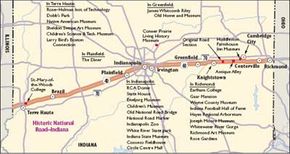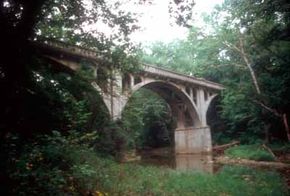One of America's earliest roads, the National Road was built between 1828 and 1834 and established a settlement pattern and infrastructure that is still visible today. Nine National Register Districts are found along the route, as are 32 individually designated National Register Sites offering education and entertainment. As you travel Indiana's Historic National Road, you find a landscape that has changed little since the route's heyday in the 1940s.
Historic villages with traditional main streets and leafy residential districts still give way to the productive fields and tranquil pastures that brought Indiana prosperity. From the Federal-style architecture of an early pike town (a town that offered traveling accommodations and little else) to the drive-ins and stainless-steel diners of the 1940s, you can literally track the westward migration of the nation in the buildings and landscapes that previous generations have left behind.
Advertisement
Along the way, you will find many of the same buildings and towns that were here during the earliest days of westward expansion. A visit to Antique Alley gives you a chance to do some antique shopping and exploring along this historic road. The Indiana Historic National Road is a unique way to experience the preserved pike towns along the route, such as Centerville and Knightstown.
The National Road also stretches into Illinois and Ohio. Keep reading to learn about the sights you'll see along the Indiana leg of this scenic drive.
Archaeological Qualities of the National Road
Eastern Indiana was the home of two groups of Native Americans identified by scholars as the Eastern Woodland Societies, who made their homes in the area following the retreat of the glaciers. One group occupied the area around 7000 to 1000 B.C., the other from approximately 1000 to 700 B.C. Many of their campsites have been found in the area of the Whitewater River Gorge. The Whitewater River Gorge was an important area after glacier movement and activity had stopped in the area. The area was excellent for hunting and fishing, with flowing streams and an abundance of resources.
Cultural Qualities of the National Road
The National Road brought the nation to Indiana. The lure of limitless opportunities and the romance of the West drew tens of thousands of pioneers through Indiana between 1834 and 1848. Many stayed and settled in the Hoosier State, thus creating a new culture -- the foundation for our national culture. This is because religious and economic groups left the distinctive colonial societies of the eastern seaboard and merged in the Midwest.
Settlers to Indiana brought with them their own particular mix of customs, religions, languages, building styles, and farming practices. Quakers, European immigrants, and African-Americans looking for new opportunities all traveled the National Road. Evidence of this mix of cultural influences can be seen along the corridor today in the buildings and landscapes. It can also be learned at the Indiana State Museum's National Road exhibit, and it can be experienced on a Conestoga Wagon at Conner Prairie Living History Museum or at a Civil War encampment along the route.
As the region matured, the culture continued to evolve under the influence of the nation's primary east-west route. Richmond was home of the Starr Piano Company, and later the Starr-Gennet recording studios, where jazz greats such as Hoagy Carmichael and Louis Armstrong made recordings in an early jazz center. The Overbeck sisters, noted for their Arts and Crafts pottery, lived and worked in Cambridge City. The poet James Whitcomb Riley, author of "Little Orphan Annie" and "Raggedy Man," lived in Greenfield.
Also, Indianapolis, the largest city on the entire National Road, became an early center for automobile manufacturing. Today, visitors experience such attractions as the Children's Museum of Indianapolis (the largest in the world) and the Eiteljorg Museum of American Indians and Western Art, as well as a variety of other museums and cultural institutions.
The National Road in Indiana represents one segment of the historic National Road corridor from Maryland to Illinois. The historic and cultural resources within Indiana are intimately tied to traditions and customs from the eastern terminus of the road in Cumberland, Maryland, and are built on goals and expectations of a nation looking west.
Historical Qualities of the National Road
The National Road was the first federally funded highway in the United States. Authorized by Thomas Jefferson in 1803, the road ran from Cumberland, Maryland, west to Vandalia, Illinois. Designed to connect with the terminus of the C&O Canal in Cumberland, the National Road gave agricultural goods and raw materials from the interior direct access to the eastern seaboard. It also encouraged Americans to settle in the fertile plains west of the Appalachians. For the first time in the United States, a coordinated interstate effort was organized and financed to survey and construct a road for both transportation purposes and economic development.
Built in Indiana between 1828 and 1834, the National Road established a settlement pattern and infrastructure that is still visible today. The historic structures along the National Road illustrate the transference of ideas and culture from the east as the road brought settlement and commerce to Indiana. The National Road passes through well-preserved, Federal-style pike towns and Victorian streetcar neighborhoods, and it is lined with early automobile-era structures, such as gas stations, diners, and motels.
Natural Qualities of the National Road
The topography of Indiana was created by glaciers that advanced and retreated over the land during the Pleistocene Period. Leaving behind moraines and an undulating landscape, the glaciers also helped to create the Whitewathemter River Gorge, where fragments of limestone, clay, and shale bedrock can be seen. The gorge and surrounding region is known internationally among geologists for its high concentration of Ordovician Period fossils.
Recreational Qualities of the National Road
You can find many opportunities for recreation along the Historic National Road in Indiana, as well as in nearby cities. Golf is a popular sport along the highway, as evidenced by the many golf courses. Biking and hiking are other extremely popular sports along the byway. Local park and recreation facilities are often directly accessible from the byway or can be found nearby.
Professional sports can be enjoyed along the byway as well. White River State Park in Indianapolis offers you an opportunity to enjoy a Triple-A baseball game at Victory Field. Just off the Historic National Road in downtown Indianapolis are the RCA Dome, home of the Indianapolis Colts, and Conseco Fieldhouse, home of the Indiana Pacers.
Find more useful information related to Indiana's National Road:
- Indiana Scenic Drives: The National Road is just one of the scenic byways in Indiana. Check out the others.
- How to Drive Economically: Fuel economy is a major concern when you're on a driving trip. Learn how to get better gas mileage.
Advertisement

